Recruitment Culture at Large Glassdoor Statistics Companies

While working on a book about machine learning interviews, I often hear from job applicants the question: what is the ratio between the number of personal interviews to job offers, that is, what percentage of people who were invited to an interview for an office, in the end, are called to work in a company . Another indicator that arouses keen interest among applicants and personnel is the level of response to offers, that is, what proportion of people who have received an invitation to work in a particular company accepts it.
Undoubtedly, hiring specialists record these statistics in each specific company, however, as far as I know, no company provides such information in the public domain. I decided to roughly calculate these figures based on the largest interview interview dataset known to me - Glassdoor. As a source, this service is far from ideal for the following reasons:
- Not many people leave reviews online
- Those who leave reviews are usually encouraged by either extremely successful or sharply negative experiences.
- Anyone who has received a job offer is more likely to leave a review than one who has not received
- The one who accepted the offer is more likely to leave a review than the one who did not accept
- Junior candidates are more likely to leave reviews than seniors
Nevertheless, I hope that the large amount of data analyzed will somewhat compensate for these imbalances. In addition, if all reviews are equally affected by the above distortions, this will not prevent them from shedding light on the differences between the companies.
This article contains six parts:
- Data - Data Set Description
- Interview results - the ratio of the number of personal interviews to the number of proposals, as well as the percentage of response to offers
- Methods for selecting applicants - in what ways candidates get for an interview in the office. Among the methods include: searching for candidates on campuses, accepting applications through online platforms, recruiting according to recommendations, working with employment agencies and using internal HR resources.
- Interview experience - which companies leave the best and worst impressions for jobseekers.
- Interview difficulty level - which companies have the most difficult tasks.
- Candidate Opinions about Companies
Data
I considered only vacancies related to programming, such as a software developer and data scientist, both for seniors and juniors (although the latter make up the bulk). The following information was extracted from each review:
- Interview Results: No Job Offer / Job Offer Accepted / Job Offer Rejected
- Difficulty: Easy Interview / Intermediate Interview / Difficult Interview
- Experience rating: Negative / Neutral / Positive
- Description: includes the application process, the selection process, tasks that were given at the interview
If some reviews did not provide the necessary information, I did not take them into account. I managed to collect 15,897 reviews related to 27 large companies, and the number of vacancies strictly for programming-related posts was at least 100 for each. Strictly speaking, a candidate can leave feedback at any stage of selection, but a review of the data shows that most Reviews were written after a personal meeting, so in the analysis I will proceed from the premise that this is true for all reviews.
Below I give the total number of reviews based on interviews with the companies in question. Apparently, it is directly proportional to the number of programmers that each of them hires. The largest number of jobs for programmers is predictably provided by Google, Amazon, Facebook and Microsoft. The relatively small number of reviews on Apple and Netflix compared to other representatives of the FAANG group is explained by the following:
- Apple is not a software company.
- Netflix is actually not such a large corporation (about 6,000 employees - compare with 40,000 employees on Facebook)
I give a breakdown of job reviews for specific positions for each company here .

The first thing that catches your eye when you look at a dataset is that the ratings of interviews vary greatly depending on the position, even within the same company. For example, only 25.4% of candidates for a data scientist position on Facebook find interviews difficult, but among those who claim to be senior software developers, this number rises to 36.4%. In the same vein, only 51% of those interviewing for the position of senior software developer rate the experience as generally positive, while among the potential data engineer, 61% of the respondents enjoy the process.
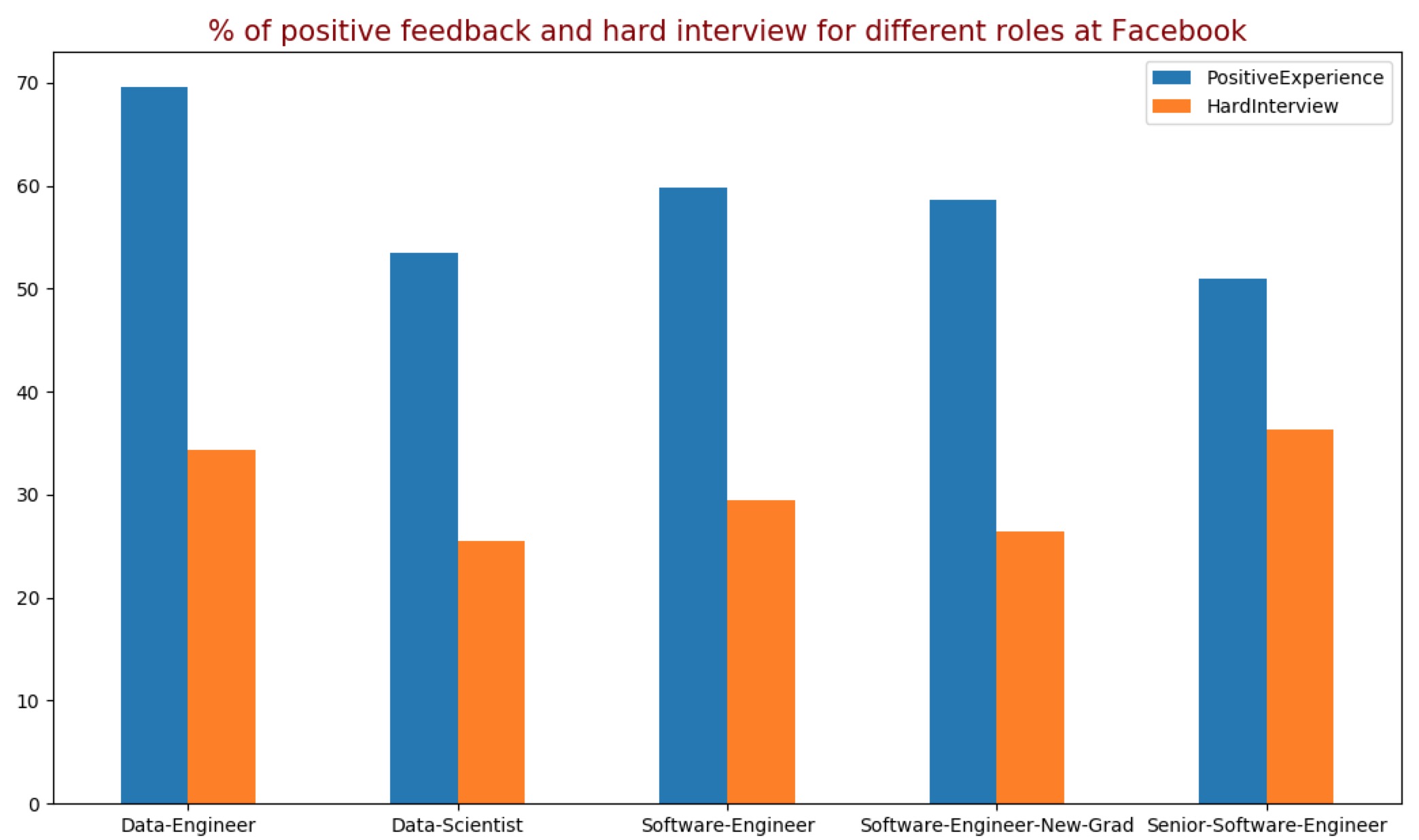
Percentage of applicants with positive experience and claims of high complexity for various posts on Facebook
The reason for these differences is that for different posts, the selection process is structured differently. So, HR officers are more often invited by seniors with “cold” e-mails, and they are contacting juniors on university campuses. The level of expectations and the course of the interview also differ. In some companies, the same scheme is established for the hiring of any employees - newcomers are assigned to specific teams after registration. But in most cases, the teams are allowed to decide for themselves how they will look for new personnel, which leads to a large spread within the same company.
Before you move on to the next paragraph, I consider it necessary to warn: take into account that reviews are not always objective and very motley. My conclusions do not draw a line, but simply give rise to a conversation.
Interview results
The first thing I wanted to know was the ratio of the number of personal interviews to the number of offers (the percentage of interviews followed by a job offer, a blue column on the graph), as well as the level of response to offers (percentage of job offers accepted by applicants, an orange column on the graph ):

As can be seen from the graph, 18.83% of applicants invited for an interview on Google are invited to work and 70% of those invited agree. Given the distortions that I cited at the beginning, it should be assumed that the real numbers are much lower. From conversations with familiar hiring professionals, as well as from some online sources, I know that the ratio of the number of interviews to the number of offers, which is given here, is several percent higher than the real values. For example, you can turn to some claims that for Google it actually amounts to 10 to 20%, and for Amazon - 20% (although we must not forget that the source of this information is anonymous from the Internet). Similarly, 90% is a completely unheard of level of response. According to personnel officers, if you have achieved that at least 80% of applicants accept your offer, you have everything in chocolate.
Ten companies with a minimal ratio of the number of interviews to the number of offers are all Internet giants (Yelp, Google, Facebook, Airbnb, Amazon, etc.). Also, all of them have a reputation for picky employers. But this does not mean that companies with a high rate take anyone horrible. Perhaps they are more stringent in the initial stages of selection and invite only those who already know or who made a very good impression. Interviews at the office are expensive, so the more offers you have per interview, the better the staffing process is streamlined.
There is a very strong correlation between the ratio of the number of interviews to the number of offers and the level of response. If we consider all 27 companies, it is 0.81. If we select only those corporations with more than 300 reviews (Apple, Uber, Amazon, Google, Microsoft, Oracle, Yelp, Cisco, IBM, Facebook), then the correlation is still higher - 0.89. By correlation, I mean that as the percentage of interviews to offers increases, so does the level of response. And this is logical: if the applicant was able to break into a company with high requirements like Google or Facebook, then they most likely have other attractive options from which to choose. Decisive companies also, as you know, offer favorable conditions - applicants can strengthen their positions in negotiations with other employers more attractive to them.
Methods for selecting applicants
The next thing that interested me was where the companies got the candidates from. Without exception, the personnel officers with whom I spoke told me that the recommendations are of great weight. But the degree of their importance varies from job to job and from company to company. For seniors, they decide the case much more often than for juniors. There are several reasons for this. Firstly, juniors are usually recommended by novice developers who lack of experience can interfere with an objective assessment of the abilities of their friends. Secondly, seniors are required to perform more organizational tasks, so that personal qualities and the ability to fit into the culture of the corporation come to the fore.
For juniors, the proportion of applicants who are invited to interview for recommendations is 10-20%; Uber is ahead of others in this regard - they have this figure of almost 30%. If we talk about seniors, the percentage rises. Salesforce, Uber and Cisco have about 30% of these per company. If we consider that the total number of people coming in on recommendations is significantly lower than the number of people who applied in other ways, it becomes obvious that the support of employees from the company greatly increases the chances.

How companies find junior jobseekers (recommendations - HR personnel - agencies - online)

How do companies find senior candidates (recommendations - personnel - agencies - online)
For junior positions, universities are the main source of recruitment. Microsoft and Oracle find more than half of their interviewees at university events - job fairs, and presentations on IT topics. Companies with a powerful Internet component (Google, Facebook, Airbnb) rely less on this method, but still it brings them from 20 to 30% of personal interviews. This means that large IT companies are throwing the lion's share of recruitment efforts to attract students from a small list of popular technical universities (also known as the Ivy Technology League: Stanford, University of California at Berkeley, MIT, California Institute of Technology, Carnegie University, University of Toronto, University of Waterloo). Later, students of these universities, settled in one of the companies, recommend their fellow students to their employers, who, in turn, recommend other fellow students. And so the movement continues in a vicious circle, which turns large IT corporations into a meeting of graduates of the Ivy Technology League.
Of course, it’s quite reasonable for the personnel to focus on the most promising sources, but from the point of view of statistics this greatly overshadows the prospects of those applicants who did not graduate from prestigious technical universities or did not graduate from universities at all. If you are one of them, I can advise you to put together an online portfolio that hiring professionals simply cannot ignore and wait for them to rush at your feet. Write thoughtful posts on technical topics in a blog or scientific articles, participate in hackathons, sign up for programming competitions and, most importantly, publish the results of your work so that everyone understands how awesome you are. From 15 to 25% of juniors, HR officers find manually, for seniors this number doubles. If you have enough experience, but do not have the necessary skills / portfolio that would attract the attention of a personnel officer, or a friend who could put in a word for you, your affairs are bad.
As a last resort, send out your resume and hope for the best. The companies that are most comfortable with trying to reach them over the Internet are Twitter, Amazon, and Airbnb; they have about half of the candidates recruited by online profiles. For those who are most likely to tell the hopeful online bidder: “Thank you, next,” they are Facebook, Microsoft, and Oracle.
Interview experience
Everyone complains that the selection process is deeply flawed. This is not entirely true, at least if you believe applicants who have received an invitation to an interview. 60% of them report positive experiences.

The ratio of the number of interviews to the number of proposals (blue box) and the percentage of positive reviews (orange column)
As befits a company known for its sales solutions, Salesforce seems to be doing very well to get the price in the eyes of applicants. Applicants who attended a personal meeting at the Salesforce office are most likely satisfied. Other companies that rank first in this indicator are Intel, Adobe, and SAP. Two companies that by all indications are not inclined to please their candidates are Netflix and Snap: in their case, only a third of applicants give positive feedback. However, they also occupy the last positions in the total number of reviews - perhaps this is due to the sampling bias.

The ratio of the number of interviews to the number of proposals (blue column) and the percentage of positive reviews (orange column)
There is a clear correlation (0.75) between the ratio between the number of interviews to the number of proposals and the share of positive responses. If you are offered a job, you are more likely to have a warm feeling in relation to the whole process. There is also a negative correlation between the percentage of negative reviews and the level of response to a job offer.
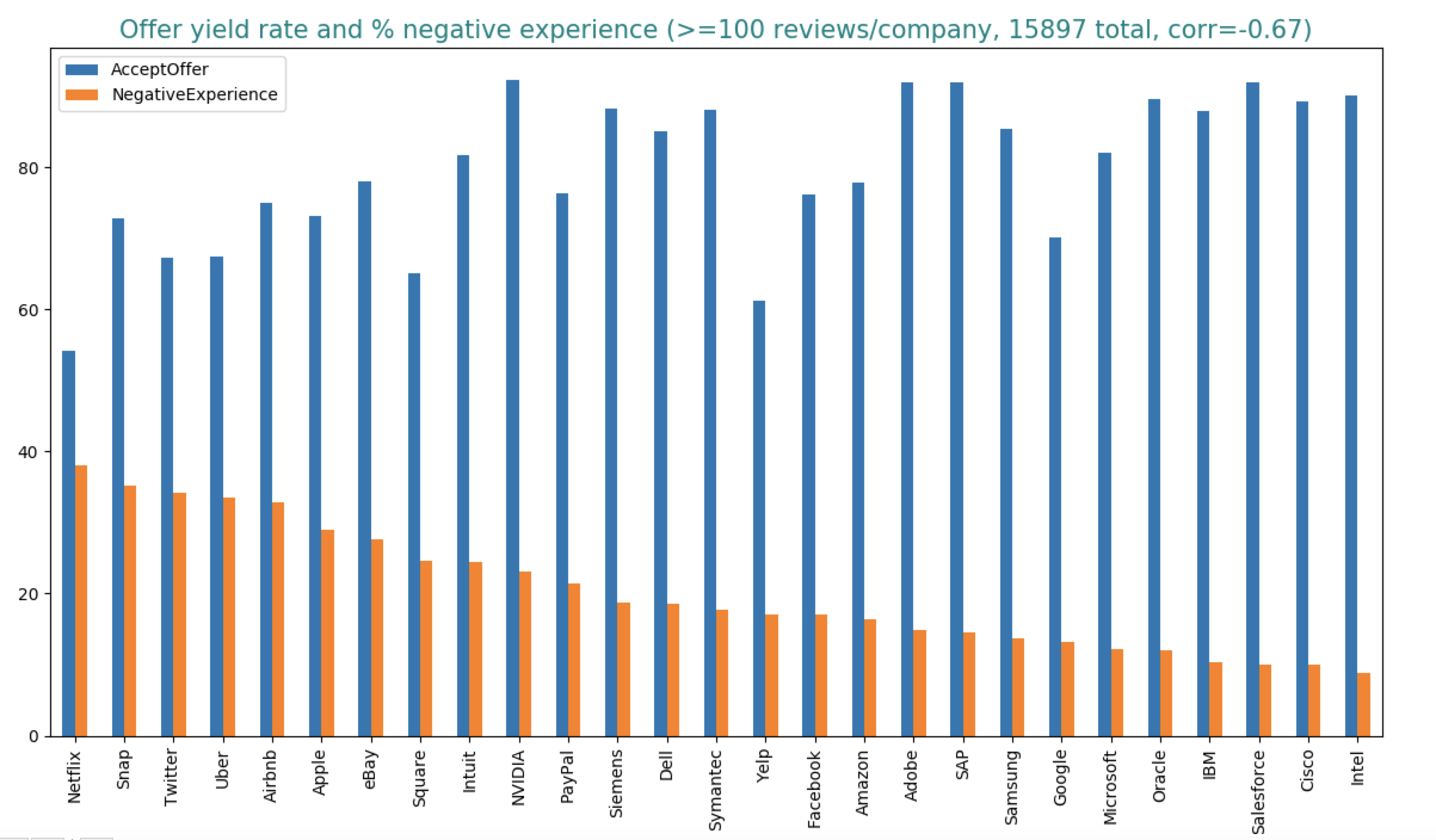
Percentage of accepted offers (blue column) and percentage of negative reviews (orange column)
The worse the applicant felt during the interview, the less likely he would be to agree to work for the company. If the applicant, who is offered a job, took the interview as a positive experience, then he will accept the offer with a probability of as much as 87.5%. If the experience was negative, the response rate is only 33.8%.
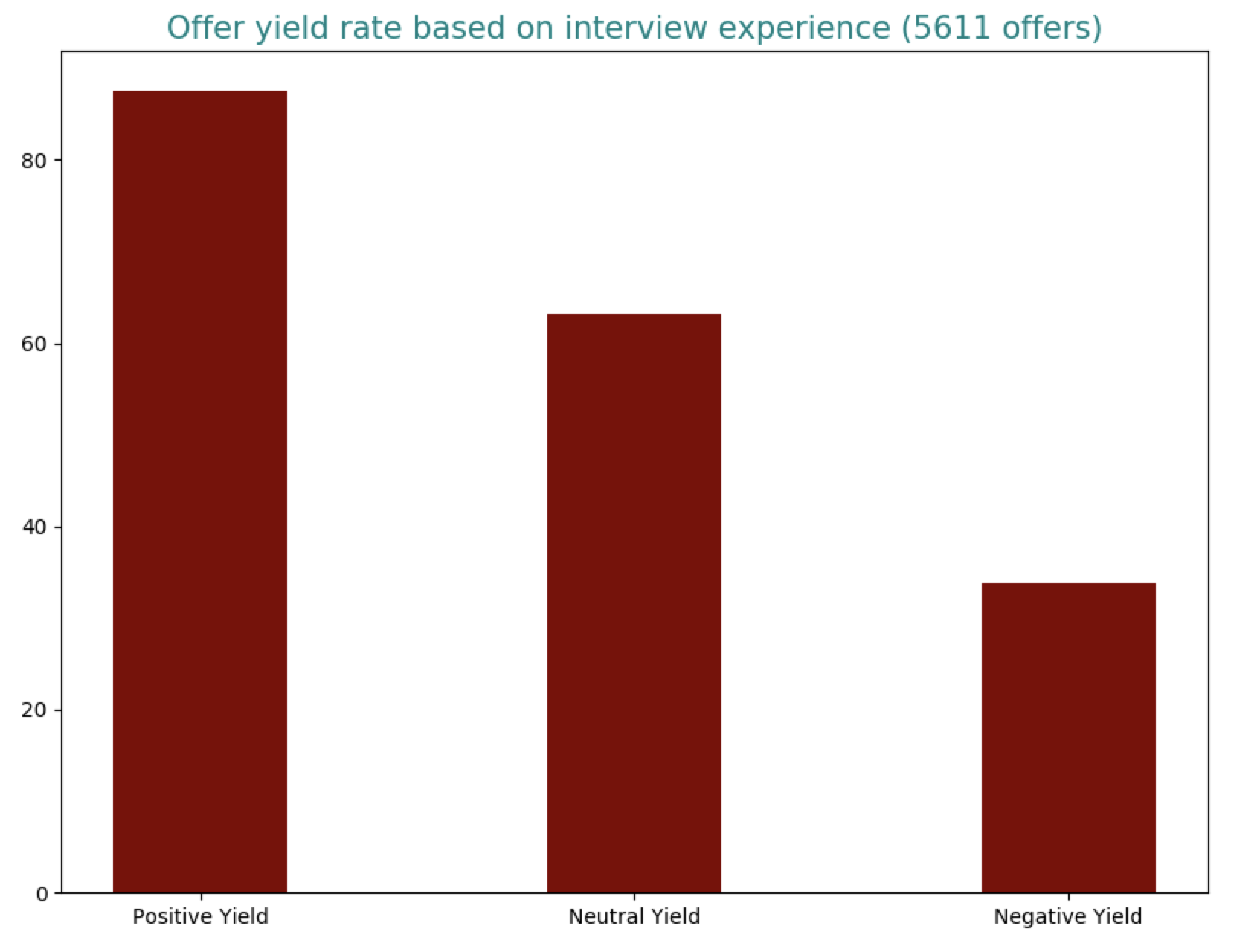
Percentage of proposals accepted for positive, neutral, and negative feedback
In general, it’s more difficult for seniors to please than for juniors. Seniors often themselves have experience in conducting interviews and, accordingly, expect more from the employer in this regard. This may explain why Netflix failed so badly. Unlike other companies that limit the number of seniors in a team to one-third, or even less, Netflix only hires them. They have no interns, and they don’t even consider fresh graduates.

Percentage of positive feedback from juniors (blue column) and seniors (orange column)
Difficulty interviews
To get started, I took the initial level of complexity of the interviews, calculated by the Glassdoor system. According to these indicators, interviews at Google and Airbnb are perceived by applicants as the most difficult, while interviews at IBM are considered the simplest.
Establishing real complexity is much more difficult. A rejected applicant is more likely to think of being interviewed for this position as difficult. The correlation between the ratio of the indicators of the interview-offer and the percentage of applicants who found the interview difficult, is -0.49.

The ratio of the number of interviews to the number of proposals (blue column) and the percentage of reviews that rate the interview as difficult (orange column)
Candidate Opinions about Companies
It seemed to me that it would be interesting to create a tag cloud for each company based on all the reviews. Previously, I deleted the names and geographical names from the text. Guess what words describe which company? These four clouds belong to Google, Netflix, Microsoft, Amazon (in random order). The answers are at the end.
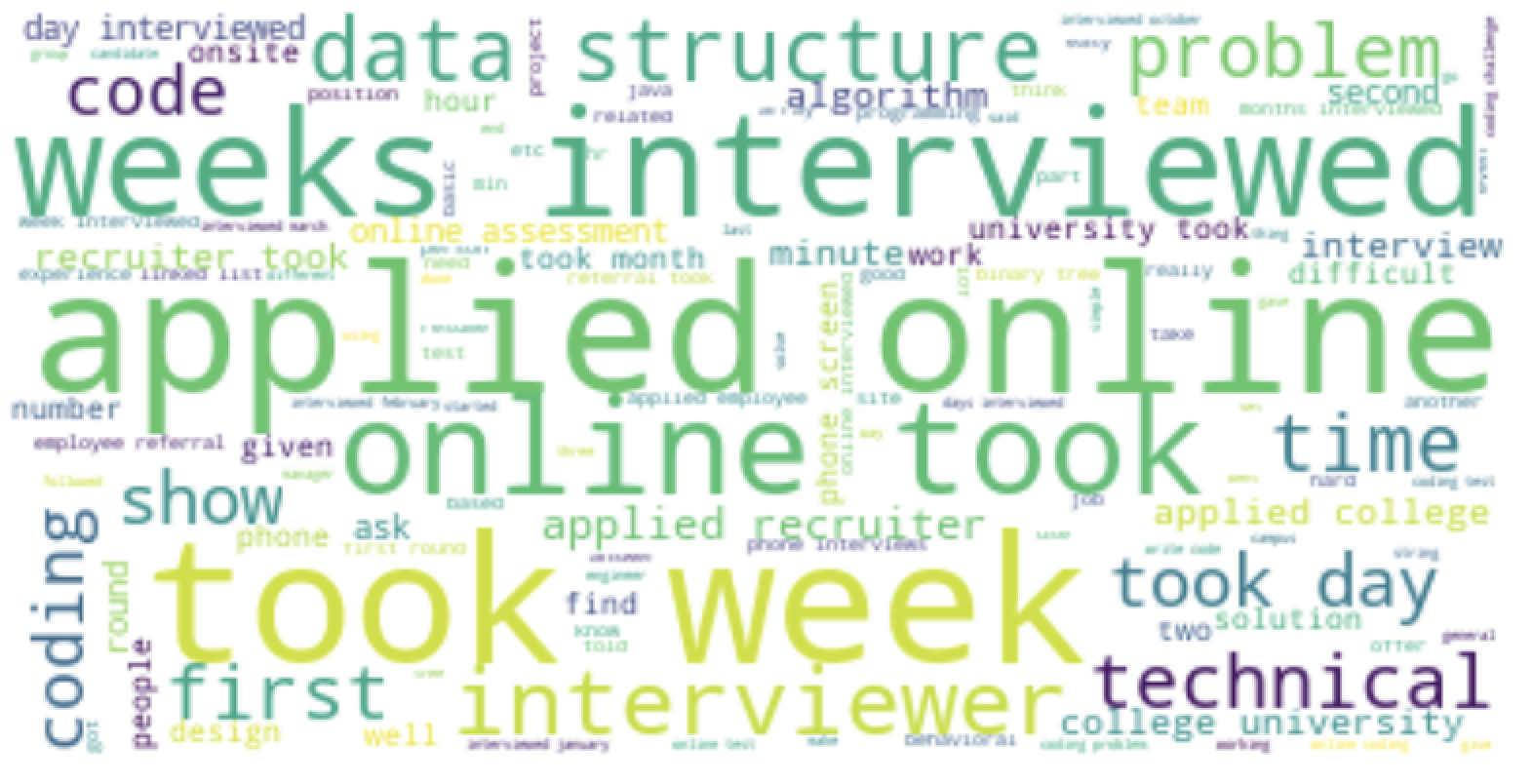
-

-
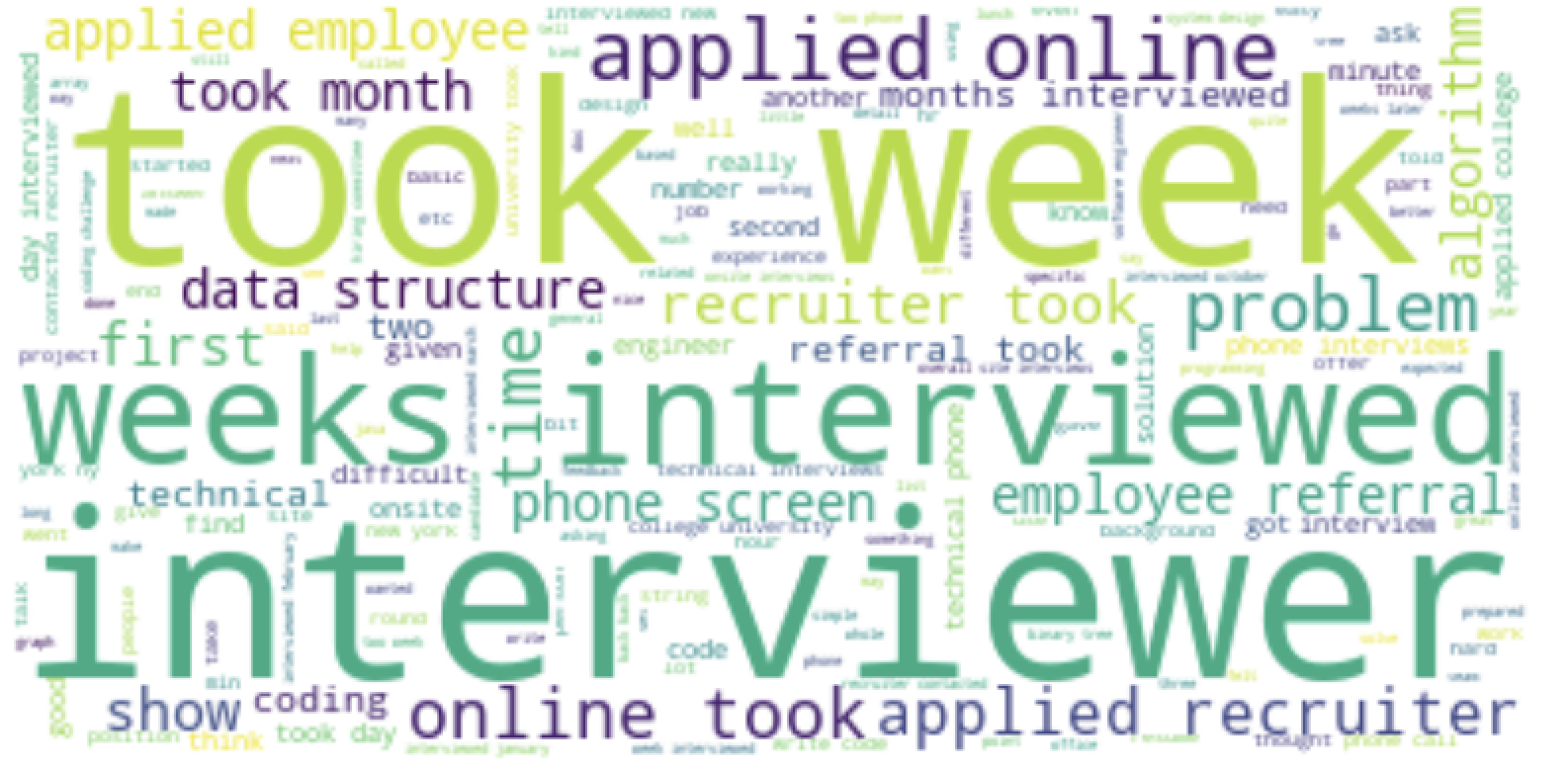
-
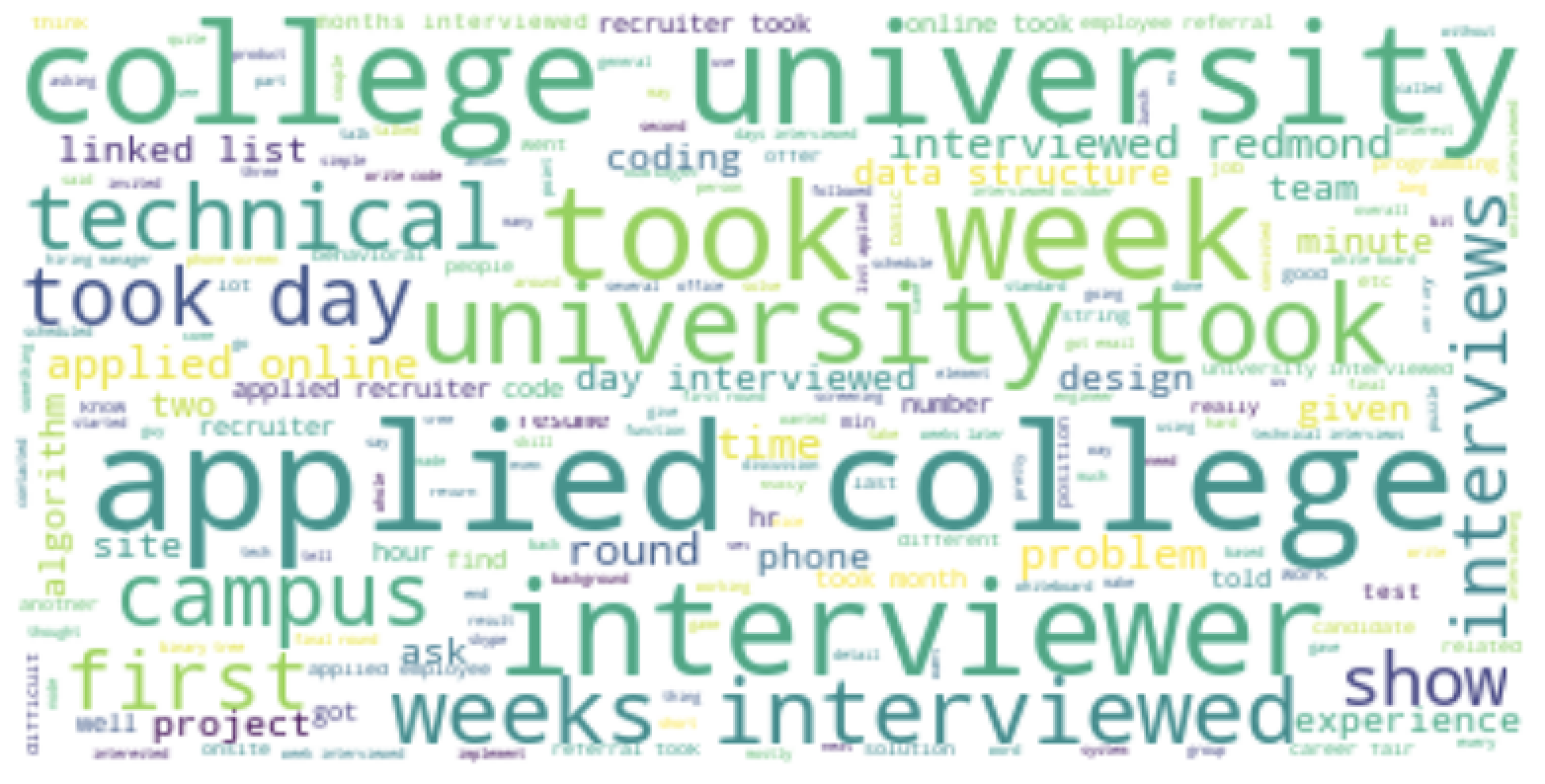
- Amazon
- Netflix
- Microsoft
All Articles